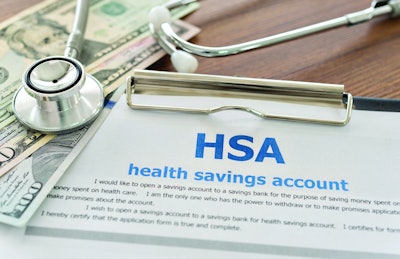 With an HSA, you're building a savings account that not only pays for your healthcare expenses, but can also be invested for tax-free growth. Photo: Getty Images
With an HSA, you're building a savings account that not only pays for your healthcare expenses, but can also be invested for tax-free growth. Photo: Getty Images
The health savings account, or HSA, is one of the most powerful and under-utilized strategies you can use to save money for healthcare and lower your taxes at the same time. Often, I think people see the term "high deductible health plan," and give no further consideration to this money-saving option. While your deductible may be high, your premium will probably be low. Thinking in terms of monthly cash flow, you could save tons just by what you don't pay out in premiums.
How You Benefit
The average employee is giving away 64% of their income, and 30% of that is in taxes. You get a great tax deduction and start reducing that 30% when you contribute to your HSA. The upfront tax deduction can even move you to a lower tax bracket. In 2017, the contribution limit on HSAs is $3,400 for single people and $6,750 for married couples. For 2018, those limits increase to $3,450 for singles and $6,900 for marrieds.
Sock that money away! This is a great way to cover your policy deductibles without the pain of paying directly out-of-pocket on money in your personal accounts that's already been taxed. An HSA puts you in a position of power when making decisions about treatments and prescriptions because you can negotiate directly with the healthcare provider, with cash. The healthcare provider will like that there is no insurance company between you and them, and they will get paid same-day. So the doctors win too.
You can also use HSA funds to pay for meals and lodging while at the hospital, and even for smoking cessation or weight loss programs, with certain stipulations. Check out IRS publication 502 for a list of the medical expenses you can take from your HSA tax-free.
With an HSA, you're building a savings account that not only pays for your healthcare expenses, but can also be invested for tax-free growth. You can earn tax-free returns in your HSA investment account, and they aren't counted toward your maximum contributions for the year. You can also spend any of those returns tax-free on your qualified medical expenses.
Here's the big kicker for an HSA: After you turn 59 1/2 it can become a second retirement. You can withdraw money from your HSA for non-healthcare expenses, though you will have to pay federal income taxes on it. This makes your HSA similar to a traditional IRA.
But think about it: You have an incentive to stay healthy during your working years and minimize your medical expenses, and as a reward, you get a second retirement. Another cool thing: There aren't mandatory disbursements like there are with traditional IRAs.
How to Get Started
So how do you set it up? Well, understand that your HSA is a completely separate account and is not related to your health
insurance.
First, you need to get the right type of health insurance that qualifies you for an HSA. That insurance is a high deductible health insurance plan (HDHP). It's open enrollment right now, so keep in mind the deadline of Dec. 15. You have until then to enroll in your employer's HDHP if you're not already in it.  You get a great tax deduction and reduce the 30% of income you normally pay in taxes when you contribute to an HSA. Photo: Getty Images
You get a great tax deduction and reduce the 30% of income you normally pay in taxes when you contribute to an HSA. Photo: Getty Images
Next, you need to set up the HSA. This won't be done through your insurance company. They only sell insurance; they don't administer savings accounts. Check with your employer and see if they facilitate opening an HSA with a local bank and making contributions straight out of your paycheck (you can choose the amount). If not, contact a local bank, or you can set one up online and make your first deposit the same day. That's what I did. My HSA is through TD Ameritrade, but there are many options. Most banks will give you a debit card to pay for medical expenses directly out of the HSA.
Once you're enrolled in your employer's HDHP and you open your HSA, you can put money in your HSA and start lowering your taxable income for 2017. You can contribute up to the maximum of $3,400 (if single) or $6,750 (if married), all under the 2017 tax year, until April 15, 2018.
You can go one step farther and, rather than just having a standard HSA, open a self-directed HSA. With a self-directed HSA, you aren't limited to just stocks and mutual funds.
You can invest in bonds, options, a franchise business, or even rental real estate. If you choose to self-direct your HSA funds, you do need to place them with a provider that allows for self-directing. Just Google "self-directed HSA providers" and do your own research, or ask for a referral from your trusted financial professional.
Knowledge is power. Now that you know about this extremely under-utilized tax savings strategy to pay for healthcare, take action. Open enrollment is now, so don't delay.
Adam Doran is a 15-year veteran police officer from the Kansas City area. You can e-mail him directly at adam@copfinance.com.














